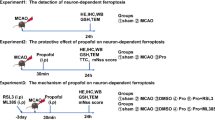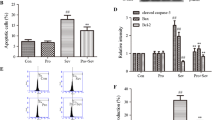Abstract
α-Synuclein is a soluble monomer abundant in the central nervous system. Aggregates of α-synuclein, consisting of higher-level oligomers and insoluble fibrils, have been observed in many chronic neurological diseases and are implicated in neurotoxicity and neurodegeneration. α-Synuclein has recently been shown to aggregate following acute ischemic stroke, exacerbating neuronal damage. Propofol is an intravenous anesthetic that is commonly used during intravascular embolectomy following acute ischemic stroke. While propofol has demonstrated neuroprotective properties following brain injury, the mechanism of protection in the setting of ischemic stroke is unclear. In this study, propofol administration significantly reduced the neurotoxic aggregation of α-synuclein, decreased the infarct area, and attenuated the neurological deficits after ischemic stroke in a mouse model. We then demonstrated that the propofol-induced reduction of α-synuclein aggregation was associated with increased mammalian target of rapamycin/ribosomal protein S6 kinase beta-1 signaling pathway activity and reduction of the excessive autophagy occurring after acute ischemic stroke.





Similar content being viewed by others
References
Iwai A, Masliah E, Yoshimoto M, Ge N, Flanagan L, de Silva HA, et al. The precursor protein of non-A beta component of Alzheimer’s disease amyloid is a presynaptic protein of the central nervous system. Neuron 1995, 14: 467–475.
Chandra S, Chen X, Rizo J, Jahn R, Südhof TC. A broken alpha-helix in folded alpha-synuclein. J Biol Chem 2003, 278: 15313–15318.
Burré J, Sharma M, Tsetsenis T, Buchman V, Etherton MR, Südhof TC. Alpha-synuclein promotes SNARE-complex assembly in vivo and in vitro. Science 2010, 329: 1663–1667.
Diógenes MJ, Dias RB, Rombo DM, Vicente Miranda H, Maiolino F, Guerreiro P, et al. Extracellular alpha-synuclein oligomers modulate synaptic transmission and impair LTP via NMDA-receptor activation. J Neurosci 2012, 34: 11750–11762.
Wong YC, Krainc D. α-Synuclein toxicity in neurodegeneration: mechanism and therapeutic strategies. Nat Med 2017, 23: 1–13.
Bartels T, Choi JG, Selkoe DJ. α-Synuclein occurs physiologically as a helically folded tetramer that resists aggregation. Nature 2011, 477: 107–110.
Pieri L, Madiona K, Bousset L, Melki R. α-Synuclein and Huntingtin exon 1 assemblies are toxic to the cells. Biophys J 2012, 102: 2894–2905.
Winner B, Jappelli R, Maji SK, Desplats PA, Boyer L, Aigner S, et al. In vivo demonstration that α-synuclein oligomers are toxic. Proc Natl Acad Sci U S A 2011, 108: 4194–4199.
Sharon R, Bar-Joseph I, Frosch MP, Walsh DM, Hamilton JA, Selkoe DJ. The formation of highly soluble oligomers of alpha-synuclein is regulated by fatty acids and enhanced in Parkinson’s disease. Neuron 2003, 37: 583–595.
Bonini NM, Giasson BI. Snaring the function of alpha-synuclein. Cell 2005, 123: 359–361.
Cremades N, Cohen SI, Deas E, Abramov AY, Chen AY, Orte A, et al. Direct observation of the interconversion of normal and toxic forms of alpha-synuclein. Cell 2012, 149: 1048–1059.
Unal-Cevik I, Gursoy-Ozdemir Y, Yemisci M, Lule S, Gurer G, Can A, et al. Alpha-synuclein aggregation induced by brief ischemia negatively impacts neuronal survival in vivo: a study in [A30P]alpha-synuclein transgenic mouse. J Cereb Blood Flow Metab 2011, 31: 913–23.
Kim T, Mehta SL, Kaimal B, Lyons K, Dempsey RJ, Vemuganti R. Poststroke induction of α-synuclein mediates ischemic brain damage. J Neurosci 2016, 36: 7055–7065.
Ham PB, Raju R. Mitochondrial function in hypoxic ischemic injury and influence of aging. Prog Neurobiol 2017, 157: 92–116.
Wang P, Shao BZ, Deng Z, Chen S, Yue Z, Miao CY. Autophagy in ischemic stroke. Prog Neurobiol 2018, 163–164: 98–117.
Gelb AW, Bayona NA, Wilson JX, Cechetto DF. Propofol anesthesia compared to awake reduces infarct size in rats. Anesthesiology 2002, 96: 1183–1190.
Zhang J, Xia Y, Xu Z, Deng X. Propofol suppressed hypoxia/reoxygenation-induced apoptosis in HBVSMC by regulation of the expression of Bcl-2, Bax, Caspase3, Kir6.1, and p-JNK. Oxid Med Cell Longev 2016, 2016: 1–11.
Song M, Yu SP, Mohamad O, Cao W, Wei ZZ, Gu X, et al. Optogenetic stimulation of glutamatergic neuronal activity in the striatum enhances neurogenesis in the subventricular zone of normal and stroke mice. Neurobiol Dis 2017, 98: 9–24.
Wei ZZ, Zhang JY, Taylor TM, Gu X, Zhao Y, Wei L. Neuroprotective and regenerative roles of intranasal Wnt-3a administration after focal ischemic stroke in mice. J Cereb Blood Flow Metab 2017, 38: 404–421.
Xiong B, Li A, Lou Y, Chen S, Long B, Peng J, et al. Precise cerebral vascular atlas in stereotaxic coordinates of whole mouse brain. Front Neuroanat 2017, 11: 128.
Woodlee MT, Asseo-García AM, Zhao X, Liu SJ, Jones TA, Schallert T. Testing forelimb placing across the midline reveals distinct, lesion-dependent patterns of recovery in rats. Exp Neurol 2005, 191: 310–317.
Feldmeyer D, Brecht M, Helmchen F, Petersen CC, Poulet JF, Staiger JF, et al. Barrel cortex function. Prog Neurobiol 2013, 103: 3–27.
Klionsky DJ, Abdelmohsen K, Abe A, Abedin MJ, Abeliovich H, Acevedo Arozena A, et al. Guidelines for the use and interpretation of assays for monitoring autophagy (3rd edition). Autophagy 2016, 12: 1–222.
Mizushima N, Yoshimori T. How to interpret LC3 immunoblotting. Autophagy 2007, 3: 542–545.
Magalhaes J, Gegg ME, Migdalska-Richards A, Doherty MK, Whitfield PD, Schapira AH. Autophagic lysosome reformation dysfunction in glucocerebrosidase deficient cells: relevance to Parkinson disease. Hum Mol Genet 2016, 25: 3432–3445.
Gao S, Duan C, Gao G, Wang X, Yang H. Alpha-synuclein overexpression negatively regulates insulin receptor substrate 1 by activating mTORC1/S6K1 signaling. Int J Biochem Cell Biol 2015, 64: 25–33.
Button RW, Roberts SL, Willis TL, Hanemann CO, Luo S. Accumulation of autophagosomes confers cytotoxicity. J Biol Chem 2017, 292: 13599–13614.
Bademosi AT, Steeves J, Karunanithi S, Zalucki OH, Gormal RS, Liu S, et al. Trapping of Syntaxin1a in presynaptic nanoclusters by a clinically relevant general anesthetic. Cell Rep 2018, 22: 427–440.
Bendor JT, Logan TP, Edwards RH. The function of alpha-synuclein. Neuron 2013, 79: 1044–1066.
Menzies FM, Fleming A, Caricasole A, Bento CF, Andrews SP, Ashkenazi A, et al. Propagation of pathological α-synuclein in marmoset brain. Acta Neuropathol Commun 2017, 5: 5–12.
Menzies FM, Fleming A, Caricasole A, Bento CF, Andrews SP, Ashkenazi A, et al. Autophagy and neurodegeneration: pathogenic mechanisms and therapeutic opportunities. Neuron 2017, 93: 1015–1034.
Grassi D, Howard S, Zhou M, Diaz-Perez N, Urban NT, Guerrero-Given D, et al. Identification of a highly neurotoxic alpha-synuclein species inducing mitochondrial damage and mitophagy in Parkinson’s disease. Proc Natl Acad Sci U S A 2018, 115: E2634–E2643.
Binolfi A, Limatola A, Verzini S, Kosten J, Theillet F, Rose HM, et al. Intracellular repair of oxidation-damaged α-synuclein fails to target C-terminal modification sites. Nature Commun 2016, 7: 10251.
Liu J, Wang X, Lu Y, Duan C, Gao G, Lu L, et al. Pink1 interacts with α-synuclein and abrogates α-synuclein-induced neurotoxicity by activating autophagy. Cell Death Dis 2017, 8: e3056.
Zhao QD, Viswanadhapalli S, Williams P, Shi Q, Tan C, Yi X, et al. NADPH oxidase 4 induces cardiac fibrosis and hypertrophy through activating Akt/mTOR and NFκB signaling pathways. Circulation 2015, 131: 643–655.
Fink AL. The aggregation and fibrillation of α-synuclein. Acc Chem Res 2006, 39: 628–634.
Acknowledgements
We thank Mengyao Qu and Yushang Zao for surgical assistance with the mouse stroke model. This work was supported by the National Natural Science Foundation of China (81771139) and the Beijing Natural Science Foundation (7194270).
Author information
Authors and Affiliations
Corresponding authors
Ethics declarations
Conflict of interest
All authors claim that there are no conflicts of interest.
Electronic supplementary material
Below is the link to the electronic supplementary material.
Rights and permissions
About this article
Cite this article
Wang, Y., Tian, D., Wei, C. et al. Propofol Attenuates α-Synuclein Aggregation and Neuronal Damage in a Mouse Model of Ischemic Stroke. Neurosci. Bull. 36, 289–298 (2020). https://doi.org/10.1007/s12264-019-00426-0
Received:
Accepted:
Published:
Issue Date:
DOI: https://doi.org/10.1007/s12264-019-00426-0




